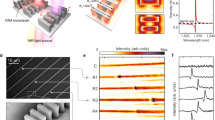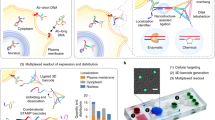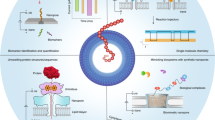Abstract
We have developed a randomly ordered fiber-optic gene array for rapid, parallel detection of unlabeled DNA targets with surface immobilized molecular beacons (MB) that undergo a conformational change accompanied by a fluorescence change in the presence of a complementary DNA target. Microarrays are prepared by randomly distributing MB-functionalized 3-μm diameter microspheres in an array of wells etched in a 500-μm diameter optical imaging fiber. Using several MBs, each designed to recognize a different target, we demonstrate the selective detection of genomic cystic fibrosis related targets. Positional registration and fluorescence response monitoring of the microspheres was performed using an optical encoding scheme and an imaging fluorescence microscope system.
This is a preview of subscription content, access via your institution
Access options
Subscribe to this journal
Receive 12 print issues and online access
$209.00 per year
only $17.42 per issue
Buy this article
- Purchase on Springer Link
- Instant access to full article PDF
Prices may be subject to local taxes which are calculated during checkout



Similar content being viewed by others
References
Nature Genetics supplement. 21:3– 50 (1999).
Ramsay, G. DNA chips: state-of-the-art. Nat. Biotechnol. 16: 40–44 (1998).
Whitecombe, D., Newton, C.R. & Little, S. Advantages in approaches to DNA-based diagnostics. Curr. Opin. Biotechnol. 9:602–608 (1998).
Burns, M.A. et al. An integrated nanoliter DNA analysis device. Science 282:484–487 (1998).
Case-Green, S. C., Mir, K. U., Pritchard, C. E. & Southern, E. M. Analyzing genetic information with DNA arrays. Curr. Opin. Chem. Biol. 2:404–410 ( 1998).
Chee, M. et al. Accessing genetic information with high-density DNA arrays. Science 274: 610–614 ( 1996).
Schena, M., Shalon, D., Davis, R. W. & Brown, P. O. Quantitative monitoring of gene expression patterns with a complementary DNA microarray . Science 270: 467–470 (1995).
McGall, G., Labadie, J., Brock, P., Wallraff, G., Nguyen, T. & Hinsberg, W. Light-directed synthesis of high-density oligonucleotide arrays using semiconductor photoresists . Proc. Natl. Acad. Sci. USA 93:13555– 13560 (1996).
Michael K. L., Taylor, L. C., Schultz, S. L. & Walt, D. R. Randomly-ordered high-density optical sensor arrays. Anal. Chem. 70:1242–1248 ( 1998).
Tyagi S., Kramer F. R. Molecular beacons: probes that fluoresce upon hybridization. Nat. Biotechnol. 14: 303–308 (1996).
Kostrikis, L. G., Tyagi, S., Mhlanga, M. M., Ho, D. D. & Kramer, F. R. Spectral genotyping of human alleles . Science 279:1228–1229 (1998).
Tyagi, S., Bratu, D. P. & Kramer, F. R. Multicolor molecular beacons for allele discrimination . Nat. Biotechnol. 16:49– 53 (1998).
Ortiz, E., Estrada, G. & Lizardi, P. M. PNA molecular beacons for rapid detection of PCR amplicons. Mol. Cell. Probes 12:219– 226 (1998).
Fang, X., Liu, X., Schuster, S. & Tan, W. Designing a novel molecular beacon for surface-immobilized DNA hybridization studies. J. Am. Chem. Soc. 127:2921–2922 (1999).
Piatek, A. S. et al. Molecular beacon sequence analysis for detecting drug resistance in Mycobacterium tuberculosis. Nat. Biotechnol. 16: 359–363 (1998).
Pantano, P. & Walt, D. R. Ordered nanowells arrays. Chem. Mater. 8:2832–2835 (1996).
Walt, D. R. Fiber optic imaging sensors. Acc. Chem. Res. 31: 267–278 (1998).
Ferguson, J. A., Boles, T. C., Adams, C. P. & Walt, D. R. A fiber-optic DNA biosensor microarray for the analysis of gene expression . Nat. Biotechnol. 14:1681– 1684 (1996).
Egner, B. J. et al. Tagging in combinatorial chemistry: the use of coloured and fluorescent beads. Chem. Commun. Vol. 8, 735– 736 (1997).
Fulton, R. J., McDade, R. L., Smith, P. L., Kienker, L. J. & Kettman, J. R. Advanced multiplexed analysis with the flowmetrix™ system. Clin. Chem. 43: 1749–1756 (1997).
Cronin, M. T., Fucini, R. V., Kim, S. M., Masino, R. S., Wespi, R. M. and Miyada, C. G. Cystic fibrosis mutation detection by hybridization to light-generated DNA probe arrays. Hum. Mutat. 7: 244–255 (1996).
Zielenski, J. et al. Identification of mutations in exons 1 through 8 of the cystic fibrosis transmembrane conductance regular (CFTR) gene. Genomics 10:29–235 (1991).
Bronk, K. S., Michael, K. L., Pantano, P. & Walt, D. R. Combined imaging and chemical sensing using a single optical fiber. Anal. Chem. 67:2750–2757 (1995).
Slaterbeck, A. F., Ridgway, T. H., Seliskar, C. J. & Heineman, W. R. Spectroelectrochemical sensing based on multimode selectivity simultaneously achievable in a single device. 3. Effect on signal averaging on limit of detection, Anal. Chem. 71:1196–1203 (1999).
Maldonado-Rodriguez, R., Espinosa-Lara, M., Calixto-Suárez, Beattie, W. G., Beattie, K. L. Hybridization of glass-tethered oligonucleotide probes to target strands preannealed with labeled auxiliary oligonucleotides. Mol. Biotechnol. 11:1– 12 (1999).
Zielenski, J. et al. Genomic DNA sequence of the cystic fibrosis transmembrane conductance regulator (CFTR) gene. Genomics 10:214– 228 (1991).
Longo, M. C., Berninger, M. S., Hartley, J. L. Use of uracil DNA glycosylase to control carry-over contamination in polymerase chain reactions. Gene 93 :125–128 (1990).
Acknowledgements
This research was supported by the National Institutes of Health (Grant GM–48142). F.S. acknowledges the Technology Foundation (S.T.W.), Technical Science Branch of the Netherlands Organization for Scientific Research (NWO) for a postdoctoral fellowship. Genomic DNA samples with characterized CFTR mutations (Wt507 and F508) were obtained as a gift from Dr. Lap-Chee Tsui and Dr. Julian Zielenski at the University of Toronto. We gratefully acknowledge the support of Dr. Yeon Kim (Tufts University) for his assistance with the asymmetric PCR.
Author information
Authors and Affiliations
Corresponding author
Rights and permissions
About this article
Cite this article
Steemers, F., Ferguson, J. & Walt, D. Screening unlabeled DNA targets with randomly ordered fiber-optic gene arrays. Nat Biotechnol 18, 91–94 (2000). https://doi.org/10.1038/72006
Received:
Accepted:
Issue Date:
DOI: https://doi.org/10.1038/72006
This article is cited by
-
FRET theoretical predictions concerning freely diffusive dyes inside spherical container: how to choose the best pair?
Photochemical & Photobiological Sciences (2021)
-
White-light upconversion emission of lanthanide double-doped oxide nanoparticles via defect state luminescence of ZnO
Science China Materials (2017)
-
Nucleic acid detection based on the use of microbeads: a review
Microchimica Acta (2014)
-
Recent Advances in DNA Microarray Technology: an Overview on Production Strategies and Detection Methods
BioNanoScience (2013)



